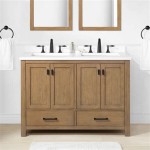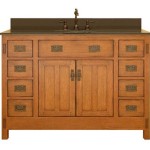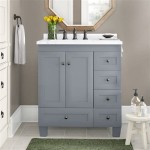Highest Rated Bathroom Sinks: A Comprehensive Guide
Selecting a bathroom sink involves more than just choosing a visually appealing fixture. It necessitates considering factors ranging from functionality and durability to style and compatibility with the overall bathroom design. This article provides a comprehensive overview of highly-rated bathroom sink options, considering various styles, materials, and mounting types to assist in making an informed purchasing decision.
Understanding Different Bathroom Sink Styles
Bathroom sinks are available in a multitude of styles, each offering distinct aesthetic and practical advantages. The choice of style significantly impacts the bathroom's overall design and functionality.
Undermount Sinks: Undermount sinks are installed beneath the countertop, creating a seamless transition between the sink and the surface. This installation method allows for easy cleaning, as debris can be wiped directly into the sink without encountering a raised lip. Undermount sinks are particularly well-suited for solid surface countertops like granite, quartz, or marble, where the edge is exposed and polished, showcasing the material's beauty. The clean lines of undermount sinks contribute to a modern and minimalist aesthetic. However, the installation process can be more complex, often requiring professional assistance, and they are generally more expensive than some other sink types.
Vessel Sinks: Vessel sinks, also known as above-counter sinks, sit directly on top of the countertop, resembling a decorative bowl. They come in a wide variety of shapes, sizes, and materials, allowing for a high degree of design flexibility. Vessel sinks can be a focal point in a bathroom, adding a touch of elegance and sophistication. Installation is generally straightforward, requiring only a hole for the drain. However, vessel sinks can be more susceptible to splashing if they are too shallow or if the faucet is positioned incorrectly. Additionally, they might require a taller vanity or a lower countertop to ensure comfortable use.
Pedestal Sinks: Pedestal sinks consist of a sink basin supported by a freestanding pedestal base. They are a classic choice, particularly well-suited for smaller bathrooms where space is limited. Pedestal sinks offer a clean and uncluttered look, concealing plumbing and providing a traditional aesthetic. However, they lack built-in storage, which might require additional storage solutions in the bathroom. Furthermore, the pedestal base can make cleaning around the sink slightly more challenging.
Wall-Mounted Sinks: Wall-mounted sinks are attached directly to the wall, freeing up floor space and creating a modern, minimalist look. They are an excellent option for bathrooms with limited square footage or for those seeking a barrier-free design. The absence of a vanity allows for easy cleaning underneath the sink. However, wall-mounted sinks require proper wall reinforcement to support their weight, and the plumbing is often exposed unless concealed with a decorative trap. Furthermore, like pedestal sinks, they offer no built-in storage.
Console Sinks: Console sinks combine the aesthetic appeal of a pedestal sink with the added functionality of a vanity. They typically feature a sink basin supported by legs or a metal frame, with a countertop area for storage. Console sinks offer a balance between form and function, providing both a stylish look and a practical storage solution. They are a good option for bathrooms that require some storage but also desire an open and airy feel.
Drop-in Sinks: Drop-in sinks, also called self-rimming sinks, are installed into a pre-cut hole in the countertop. The rim of the sink sits on top of the countertop, creating a finished look. Drop-in sinks are relatively easy to install and are available in a wide range of materials and styles. They are a versatile option that can be used in various bathroom designs. However, the rim can create a lip that can trap dirt and debris, making cleaning slightly more challenging.
Evaluating Common Bathroom Sink Materials
The material of a bathroom sink significantly influences its durability, appearance, and maintenance requirements. Different materials offer varying degrees of resistance to stains, scratches, and temperature changes. Selecting the appropriate material is crucial for ensuring the long-term performance and aesthetic appeal of the sink.
Vitreous China: Vitreous china is a popular choice for bathroom sinks due to its durability, affordability, and resistance to stains and scratches. It is a non-porous material that is easy to clean and maintain. Vitreous china sinks are available in a wide range of colors and styles, making them a versatile option for various bathroom designs. However, while durable, vitreous china can chip or crack if subjected to significant impact.
Porcelain: Porcelain is another common material for bathroom sinks, often used interchangeably with vitreous china. However, porcelain is generally considered to be a more durable and higher-quality material. It is also non-porous and resistant to stains and scratches. Porcelain sinks are available in a wide range of colors and styles, similar to vitreous china. The distinction between porcelain and vitreous china can sometimes be subtle, with the "vitreous" designation referring to the enamel coating applied to the porcelain.
Cast Iron: Cast iron sinks are known for their exceptional durability and resistance to chipping and cracking. They are typically coated with enamel, which provides a smooth and glossy surface. Cast iron sinks offer a classic and timeless look, and they are available in a range of colors. However, cast iron sinks are very heavy, requiring strong support structures, and they can be more expensive than other sink options.
Stainless Steel: Stainless steel sinks are a popular choice for modern bathrooms due to their sleek and contemporary look. They are durable, resistant to stains and corrosion, and easy to clean. Stainless steel sinks are also relatively lightweight compared to other materials. However, they can be prone to scratches and water spots, requiring regular cleaning to maintain their appearance. Furthermore, stainless steel can sometimes be noisy when water is running into the sink.
Glass: Glass sinks offer a unique and elegant aesthetic, adding a touch of sophistication to the bathroom. They are available in a variety of colors, shapes, and textures, allowing for a high degree of design flexibility. Glass sinks are non-porous and easy to clean, but they can be more susceptible to chipping and cracking than other materials. Thick-tempered glass is recommended for bathroom sinks to ensure durability. Special care should be taken when cleaning glass sinks to avoid scratching the surface.
Stone: Stone sinks, such as granite or marble, offer a luxurious and natural look. They are durable and resistant to stains and scratches, but they can be more porous than other materials, requiring regular sealing to prevent water absorption. Stone sinks are also relatively heavy, requiring strong support structures. The natural variations in the stone add to their unique character, but it is important to select a stone with the desired color and pattern.
Solid Surface: Solid surface materials, such as Corian or Swanstone, are a blend of natural minerals and acrylic polymers. They are durable, non-porous, and resistant to stains and scratches. Solid surface sinks are also renewable, meaning that scratches and stains can be sanded away. They are available in a wide range of colors and patterns, and they can be seamlessly integrated with solid surface countertops.
Considering Mounting Options and Plumbing Requirements
The mounting option for a bathroom sink directly affects the installation process and the overall appearance of the bathroom. Furthermore, understanding the plumbing requirements is essential for ensuring proper functionality and preventing leaks.
Above-Counter Mounting: As described earlier, vessel sinks are the primary example of above-counter mounting. The primary plumbing concern is ensuring the faucet height is appropriate. A faucet that is too short will be difficult to use, while a faucet that is too tall may cause excessive splashing.
Below-Counter Mounting: Undermount sinks require careful attention to the countertop cutout. The cutout must be precise to ensure a proper fit and prevent leaks. The sink is typically attached to the countertop using clips and adhesive sealant. The plumbing connections are standard, but it is essential to ensure that the drain is properly aligned with the waste pipe.
Wall Mounting: Wall-mounted sinks require a robust wall structure to support the weight of the sink and its contents. The wall must be properly reinforced, and the mounting hardware must be securely attached. The plumbing connections are typically exposed, requiring a decorative trap kit to conceal the pipes and provide a finished look. The height of the sink is also important, ensuring that it is comfortable to use for all members of the household.
Vanity Integration: Sinks integrated into a vanity unit offer a seamless and integrated look. The vanity provides support for the sink and conceals the plumbing connections. The plumbing connections are standard, but it is essential to ensure that the drain is properly aligned with the waste pipe. The faucet must be compatible with the pre-drilled holes in the countertop or sink.
Plumbing Considerations: Regardless of the mounting option, several plumbing considerations are crucial. These include ensuring proper drain size, using appropriate plumbing fittings, and checking for leaks after installation. It is also important to comply with local plumbing codes and regulations. If unsure, consulting a licensed plumber is highly recommended to ensure a safe and proper installation.
Beyond the sink itself, faucets play a crucial role in both the function and aesthetics of the space. Choosing the right faucet style, finish, and features will complement the sink and enhance the overall bathroom design. Consider factors like water flow rate, handle type, and spout height when selecting a faucet. Additionally, ensure the faucet is compatible with the sink's pre-drilled holes.
The selection of a bathroom sink is a multifaceted decision that requires careful consideration of style, material, mounting options, and plumbing considerations. By thoroughly evaluating these factors, one can choose a sink that meets their functional needs, complements their bathroom design, and provides long-lasting performance.

Common Sink Sizes How To Choose The Right Bathroom 2024

Bathroom Vanity Styles To Fit Your Space Forbes Home

Types Of Bathroom Sinks The Home Depot

Bathroom Sinks The Home Depot

Bathroom Sinks Lowe S

Bathroom Sinks The Home Depot

Unique Shape Table Mounted White Bathroom Washbasin Fuao

Large Round White Countertop Ridged Basin Bowl 400mm Aspra

Clear Glass 420mm Square Wash Basin Counter Mounted Padova

Luxury Wash Basins From Fuao Bowl Shaped Golden Yellow Color
Related Posts







